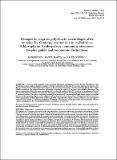Por favor, use este identificador para citar o enlazar a este item:
http://hdl.handle.net/10261/317852COMPARTIR / EXPORTAR:
 SHARE SHARE
 CORE
BASE CORE
BASE
|
|
| Visualizar otros formatos: MARC | Dublin Core | RDF | ORE | MODS | METS | DIDL | DATACITE | |

| Campo DC | Valor | Lengua/Idioma |
|---|---|---|
| dc.contributor.author | Box, Antonio | es_ES |
| dc.contributor.author | Martin, Daniel | es_ES |
| dc.contributor.author | Deudero, Salud | es_ES |
| dc.coverage.spatial | Mediterranean Sea | en_US |
| dc.coverage.spatial | Western Mediterranean Sea | en_US |
| dc.coverage.spatial | Balearic Sea | en_US |
| dc.date.accessioned | 2023-06-21T06:06:30Z | - |
| dc.date.available | 2023-06-21T06:06:30Z | - |
| dc.date.issued | 2010 | es_ES |
| dc.identifier.citation | Scientia Marina, 74(2). 2010: 317-329 | es_ES |
| dc.identifier.uri | http://hdl.handle.net/10261/317852 | - |
| dc.description.abstract | A two-year study focusing on the associated polychaete assemblages revealed that the degradation of the Posidonia oceanica seagrass meadows, together with the colonisation of rhizomes by invasive Caulerpa racemosa in the Balearic Islands, have produced important changes in the ecosystem functioning, and have therefore affected the benthic faunal communities. The highest abundance and number of species occurred in C. racemosa from August to December. The species composition of the polychaete assemblage in C. racemosa is similar to that of P. oceanica but abundances of shared species differ between Caulerpa and Posidonia. Abundance, number of species and diversity were positively correlated with C. racemosa biomass. The spatial complexity provided by the network of C. racemosa fronds and stolons seemed to combine with that of the remaining seagrass mat to support a well developed polychaete assemblage. Although invaded meadows harboured significantly modified polychaete assemblages when compared with living P. oceanica meadows, the main impacts seem to be non-harmful (i.e. increased abundance and number of species) and mainly affect their seasonal patterns, which is a direct consequence of the corresponding biomass seasonality of C. racemosa | en_US |
| dc.language.iso | eng | en_US |
| dc.relation.ispartof | Centro Oceanográfico de Baleares | - |
| dc.rights | openAccess | es_ES |
| dc.subject | Posidonia oceanica | |
| dc.subject | Medio Marino | es_ES |
| dc.subject | Centro Oceanográfico de Baleares | es_ES |
| dc.subject | Caulerpa racemosa | |
| dc.subject | Polychaeta | en_US |
| dc.subject | species diversity | en_US |
| dc.subject | trophic guilds | en_US |
| dc.subject | taxonomic distinctness | en_US |
| dc.subject | introduced species | en_US |
| dc.subject | Mediterranean | en_US |
| dc.title | Changes in seagrass polychaete assemblages after invasion by Caulerpa racemosa var. cylindracea (Chlorophyta: Caulerpales): community structure, trophic guilds and taxonomic distinctness | en_US |
| dc.type | artículo | es_ES |
| dc.identifier.doi | 10.3989/scimar.2010.74n2317 | |
| dc.description.peerreviewed | Sí | es_ES |
| dc.relation.publisherversion | http://www.icm.csic.es/scimar/index.php/secId/6/IdArt/3894/ | |
| dc.rights.license | http://creativecommons.org/licenses/by-nc-nd/3.0/es/ | es_ES |
| dc.type.coar | http://purl.org/coar/resource_type/c_6501 | es_ES |
| dc.journal.title | Scientia Marina | es_ES |
| dc.page.initial | 317 | es_ES |
| dc.page.final | 329 | es_ES |
| dc.volume.number | 74(2) | es_ES |
| dc.identifier.sipi | 3075 | es_ES |
| item.openairetype | artículo | - |
| item.cerifentitytype | Publications | - |
| item.grantfulltext | open | - |
| item.fulltext | With Fulltext | - |
| item.openairecristype | http://purl.org/coar/resource_type/c_18cf | - |
| item.languageiso639-1 | en | - |
| Aparece en las colecciones: | (IEO) Artículos | |
Ficheros en este ítem:
| Fichero | Descripción | Tamaño | Formato | |
|---|---|---|---|---|
| sm74n2317.pdf | 589,03 kB | Adobe PDF |  Visualizar/Abrir |
CORE Recommender
SCOPUSTM
Citations
40
checked on 11-may-2024
WEB OF SCIENCETM
Citations
34
checked on 25-feb-2024
Page view(s)
48
checked on 17-may-2024
Download(s)
19
checked on 17-may-2024
Google ScholarTM
Check
Altmetric
Altmetric
Este item está licenciado bajo una Licencia Creative Commons

